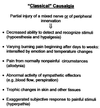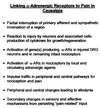Causalgia, pathological pain, and adrenergic receptors
- PMID: 10393877
- PMCID: PMC33598
- DOI: 10.1073/pnas.96.14.7664
Causalgia, pathological pain, and adrenergic receptors
Abstract
Control of expression of molecular receptors for chemical messengers and modulation of these receptors' activity are now established as ways to alter cellular reaction. This paper extends these mechanisms to the arena of pathological pain by presenting the hypothesis that increased expression of alpha-adrenergic receptors in primary afferent neurons is part of the etiology of pain in classical causalgia. It is argued that partial denervation by lesion of peripheral nerve or by tissue destruction induces a change in peripheral nociceptors, making them excitable by sympathetic activity and adrenergic substances. This excitation is mediated by alpha-adrenergic receptors and has a time course reminiscent of experimental denervation supersensitivity. The change in neuronal phenotype is demonstrable after lesions of mixed nerves or of the sympathetic postganglionic supply. Similar partial denervations also produce a substantial increase in the number of dorsal root ganglion neurons evidencing the presence of alpha-adrenergic receptors. The hypothesis proposes the increased presence of alpha-adrenergic receptors in primary afferent neurons to result from an altered gene expression triggered by cytokines/growth factors produced by disconnection of peripheral nerve fibers from their cell bodies. These additional adrenergic receptors are suggested to make nociceptors and other primary afferent neurons excitable by local or circulating norepinephrine and epinephrine. For central pathways, the adrenergic excitation would be equivalent to that produced by noxious events and would consequently evoke pain. In support, evidence is cited for a form of denervation supersensitivity in causalgia and for increased expression of human alpha-adrenergic receptors after loss of sympathetic activity.
Figures
References
-
- Mitchell W. Injuries of Nerves and Their Consequences. Philadelphia: Lippincott; 1872.
-
- Leriche R. Presse Méd. 1916;24:178–180.
-
- Evans J A. Surg Clin North Am. 1946;26:435–448. - PubMed
-
- Merskey H, Bogduk N. Classification of Chronic Pain: Descriptions of Chronic Pain Syndromes and Definition of Terms. Seattle: IASP Press; 1995.
-
- Kozin F, McCarty D J, Sims J, Genant H. Am J Med. 1976;60:321–331. - PubMed
Publication types
MeSH terms
Substances
Grants and funding
LinkOut - more resources
Full Text Sources
Medical




